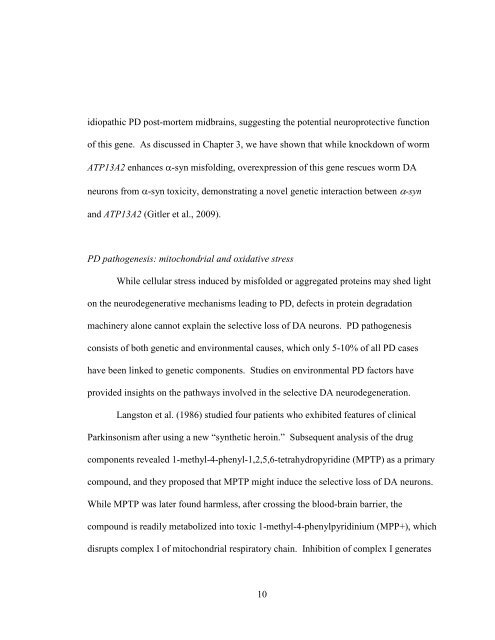identification of neuroprotective genes against alpha - acumen - The ...
identification of neuroprotective genes against alpha - acumen - The ...
identification of neuroprotective genes against alpha - acumen - The ...
Create successful ePaper yourself
Turn your PDF publications into a flip-book with our unique Google optimized e-Paper software.
idiopathic PD post-mortem midbrains, suggesting the potential <strong>neuroprotective</strong> function<br />
<strong>of</strong> this gene. As discussed in Chapter 3, we have shown that while knockdown <strong>of</strong> worm<br />
ATP13A2 enhances α-syn misfolding, overexpression <strong>of</strong> this gene rescues worm DA<br />
neurons from α-syn toxicity, demonstrating a novel genetic interaction between α-syn<br />
and ATP13A2 (Gitler et al., 2009).<br />
PD patho<strong>genes</strong>is: mitochondrial and oxidative stress<br />
While cellular stress induced by misfolded or aggregated proteins may shed light<br />
on the neurodegenerative mechanisms leading to PD, defects in protein degradation<br />
machinery alone cannot explain the selective loss <strong>of</strong> DA neurons. PD patho<strong>genes</strong>is<br />
consists <strong>of</strong> both genetic and environmental causes, which only 5-10% <strong>of</strong> all PD cases<br />
have been linked to genetic components. Studies on environmental PD factors have<br />
provided insights on the pathways involved in the selective DA neurodegeneration.<br />
Langston et al. (1986) studied four patients who exhibited features <strong>of</strong> clinical<br />
Parkinsonism after using a new “synthetic heroin.” Subsequent analysis <strong>of</strong> the drug<br />
components revealed 1-methyl-4-phenyl-1,2,5,6-tetrahydropyridine (MPTP) as a primary<br />
compound, and they proposed that MPTP might induce the selective loss <strong>of</strong> DA neurons.<br />
While MPTP was later found harmless, after crossing the blood-brain barrier, the<br />
compound is readily metabolized into toxic 1-methyl-4-phenylpyridinium (MPP+), which<br />
disrupts complex I <strong>of</strong> mitochondrial respiratory chain. Inhibition <strong>of</strong> complex I generates<br />
10

















